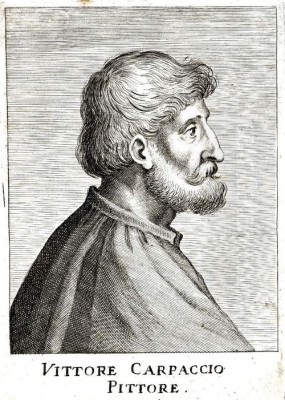
Vittore Carpaccio stands as one of the most distinctive and engaging painters of the Venetian Renaissance. Active during the late fifteenth and early sixteenth centuries, he captured the unique spirit, pageantry, and daily life of Venice with unparalleled detail and narrative charm. While perhaps less revolutionary than some of his contemporaries, Carpaccio developed a highly personal style that blended meticulous observation with a gentle, poetic sensibility. His large narrative canvases, often commissioned by the city's influential confraternities, or Scuole, serve not only as artistic masterpieces but also as invaluable historical documents, offering a vivid window into the world of La Serenissima at the height of its power and cultural vibrancy.
Early Life and Artistic Formation
Pinpointing Vittore Carpaccio's exact birth year remains a subject of scholarly discussion, but it is generally placed between 1460 and 1465. He was born in Venice, or possibly Capodistria (modern Koper in Slovenia), which was then part of the Venetian Republic. His family name might have originally been Scarpazza or Scarpazo. He spent the vast majority of his life and career in Venice, deeply immersing himself in the city's unique atmosphere, which would become central to his art. His death is recorded as occurring in 1525 or 1526.
The artistic environment Carpaccio entered was dominated by the Bellini family workshop. While direct documentary proof of his apprenticeship is lacking, his early works show a clear affinity with the prevailing Venetian style, particularly the influence of Giovanni Bellini, the leading master of the time. From Bellini, Carpaccio likely absorbed the sensitivity to light and color that characterized the Venetian school. However, some art historians also propose Lazzaro Bastiani, a more conservative painter known for his narrative works, as a possible early teacher, which might account for Carpaccio's strong inclination towards storytelling.
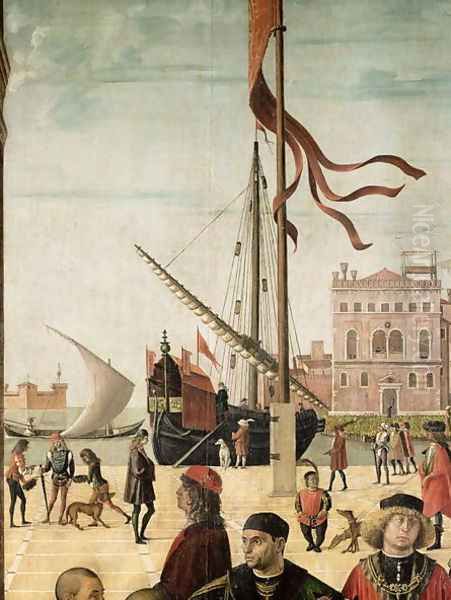
Another crucial influence was Antonello da Messina, the Sicilian painter who visited Venice in 1475-1476. Antonello brought with him a mastery of the oil painting techniques pioneered by Early Netherlandish artists like Jan van Eyck and Rogier van der Weyden, along with their penchant for sharp focus and meticulous detail. Carpaccio’s own careful rendering of textures, surfaces, and intricate details suggests he absorbed these lessons, possibly directly or through the works of Giovanni Bellini, who was also profoundly impacted by Antonello. The clarity of light and spatial construction in Carpaccio's work also echoes Netherlandish precedents.
Furthermore, the influence of Gentile Bellini, Giovanni's brother, cannot be overlooked. Gentile specialized in large-scale narrative paintings depicting Venetian ceremonies and historical events, known as teleri. Carpaccio would become a master of this genre, and Gentile's approach to organizing complex scenes crowded with figures within recognizable Venetian settings likely provided a significant model. Elements from the Paduan school, particularly the sharp linearity and interest in perspective associated with Andrea Mantegna (Giovanni and Gentile's brother-in-law), may also have played a role, though Carpaccio’s style remained softer and less overtly classical than Mantegna's.
The Venetian Scuole and Narrative Cycles
Understanding Carpaccio's career requires understanding the unique socio-religious institutions of Venice known as the Scuole. These were lay confraternities, often organized around patron saints or charitable activities, playing a vital role in the city's social fabric. The wealthier Scuole Grandi and numerous Scuole Piccole commissioned extensive decorative cycles for their meeting houses, often depicting the lives of their patron saints or miraculous events associated with relics they possessed. These commissions provided Venetian artists, including Carpaccio, with opportunities to create large-scale narrative works on canvas (teleri), as fresco painting was less suitable for Venice's damp climate.
Carpaccio excelled in this format. His particular talent lay in translating complex stories into visually engaging sequences, filling them with anecdotal detail and embedding them within meticulously rendered Venetian or imagined architectural settings. These commissions allowed him to showcase his skills in composition, perspective, and the depiction of crowds, costumes, and everyday objects, effectively bringing sacred stories into the contemporary world of his patrons. His work for the Scuole cemented his reputation and provides us with his most celebrated masterpieces.
Masterpiece for the Scuola di Sant'Orsola: The Legend of Saint Ursula
Between 1490 and 1496, Carpaccio undertook his first major narrative cycle for the Scuola di Sant'Orsola (Saint Ursula). This series of nine large canvases depicts the elaborate and ultimately tragic story of Saint Ursula, a Breton princess who, according to legend, agreed to marry a pagan English prince only on the condition that he convert to Christianity and accompany her on a pilgrimage to Rome with her 11,000 virgin companions. On their return journey, they were martyred by Huns near Cologne.
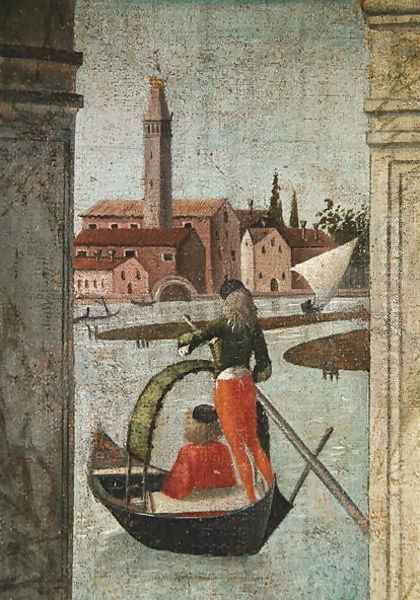
Carpaccio unfolds this complex narrative with remarkable clarity and charm. He sets the scenes in fantastical architectural spaces that often blend contemporary Venetian elements with imaginative reconstructions of foreign locales like Brittany, England, Rome, and Cologne. The paintings are filled with meticulously observed details of costume, furnishings, ships, and cityscapes, creating a vibrant tapestry of late 15th-century life interwoven with the religious legend.
One of the most famous panels is The Dream of Saint Ursula. It depicts the princess asleep in her meticulously rendered bedroom, bathed in the soft morning light entering through the window. An angel appears, bearing the palm of martyrdom, foretelling her fate. The intimacy of the scene, the peaceful atmosphere, and the exquisite rendering of details – the furniture, the small dog asleep at the foot of the bed, the potted plants on the windowsill – make it a high point of Venetian Quattrocento painting.
Other panels, like The Arrival of the Ambassadors and The Departure of the Ambassadors, showcase Carpaccio's skill in handling complex group compositions and depicting diplomatic pageantry. The Meeting of Ursula and the Prince and their Departure on Pilgrimage captures the blend of courtly romance and solemn purpose. The final scenes, depicting the Pilgrims' Arrival in Rome and the Martyrdom and Funeral of Saint Ursula, convey the dramatic climax with pathos, though always tempered by Carpaccio's characteristic restraint and decorative sensibility. The entire cycle, now housed in the Gallerie dell'Accademia in Venice, stands as a testament to Carpaccio's narrative genius and his ability to create enchanting, believable worlds.
The Scuola di San Giorgio degli Schiavoni Cycle
Following the success of the Saint Ursula cycle, Carpaccio received another major commission around 1502 from the Scuola di San Giorgio degli Schiavoni (Saint George of the Dalmatians). This confraternity served the Dalmatian community in Venice. Carpaccio decorated their ground-floor meeting room with a series of panels depicting episodes from the lives of their patron saints: Saint George, Saint Tryphon, and Saint Jerome. These paintings remain in situ, providing a unique opportunity to experience Carpaccio's work in its original setting.
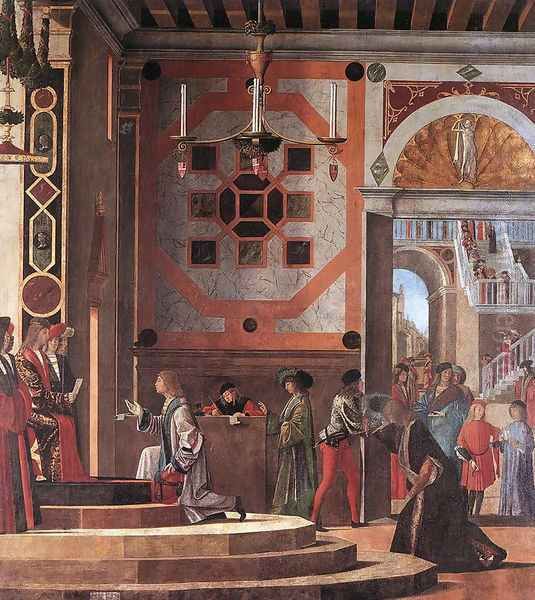
Perhaps the most dramatic panel is Saint George and the Dragon. Carpaccio portrays the climactic moment with theatrical flair: Saint George, mounted on his horse, charges towards the ferocious dragon, his lance piercing its head. The ground is gruesomely littered with the remains of previous victims. In the background, the rescued princess looks on, framed by an exotic cityscape. The energy of the composition, the detailed rendering of the dragon, and the dramatic landscape create a powerful image of chivalric heroism.
In contrast, the panels dedicated to Saint Jerome offer scenes of quiet contemplation and gentle wonder. Saint Jerome Leading the Lion into the Monastery depicts the saint calmly bringing the tamed beast, from whose paw he had removed a thorn, into a monastic courtyard, causing understandable panic among the monks. The scene blends gentle humor with a sense of the miraculous.
Even more celebrated is Saint Augustine in His Study, often interpreted as depicting Saint Jerome in his study receiving a premonition of Saint Augustine's death (or vice versa, the iconography is debated). Regardless of the precise subject, the painting is renowned for its incredibly detailed depiction of a scholar's study. Books, scientific instruments, objets d'art, and sheet music are scattered across shelves and tables, illuminated by a clear, tranquil light streaming through the windows. A small white dog looks attentively towards the saint, who pauses in his writing, struck by a divine message. The painting is a masterful evocation of intellectual life and spiritual revelation, rendered with Carpaccio's signature precision and atmospheric sensitivity. Other panels in the cycle include The Funeral of Saint Jerome and Saint Tryphon Exorcising the Emperor's Daughter.
Other Narrative and Devotional Works
Carpaccio also contributed to other collaborative projects for the Scuole. Around 1494, he painted The Miracle of the Relic of the True Cross at the Rialto Bridge for the Scuola Grande di San Giovanni Evangelista. This work, part of a larger cycle by various artists including Gentile Bellini and Giovanni Mansueti, depicts a bustling scene on and around the old wooden Rialto Bridge, showcasing Carpaccio's ability to capture the vibrant life of the city and integrate a miraculous event – the exorcism of a possessed man – into a detailed urban panorama.
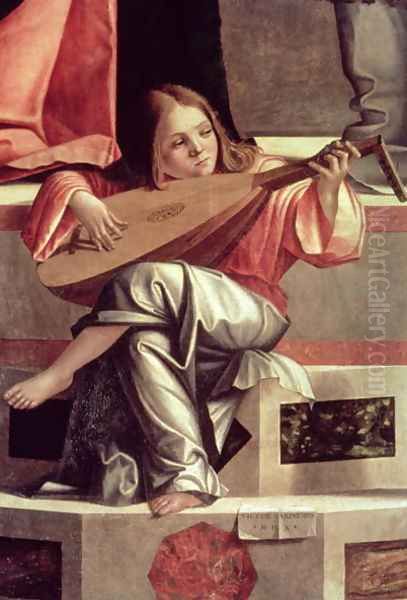
Beyond the large narrative cycles, Carpaccio produced numerous altarpieces and smaller devotional paintings. Works like the Presentation of Jesus in the Temple (1510) show his ability to handle more traditional religious subjects, though often imbued with his characteristic attention to detail and setting. The Debate of St. Stephen (c. 1514) demonstrates his continued engagement with narrative, depicting the saint preaching before a crowd in an elaborate architectural setting. The Lion of St. Mark (1516), painted for the Doge's Palace, is a powerful symbol of Venetian statehood, depicting the winged lion against a backdrop showing the Doge's Palace, the Piazzetta, and the lagoon.
Artistic Style and Technique
Vittore Carpaccio's style is characterized by several key elements. First and foremost is his narrative clarity. He possessed an exceptional ability to tell a story visually, organizing complex scenes logically and guiding the viewer's eye through the unfolding events. His compositions are often carefully constructed using linear perspective, creating believable, stage-like spaces for his figures to inhabit.
His attention to detail is legendary. Carpaccio delighted in rendering the textures of fabrics, the gleam of armor, the intricacies of architecture, and the small incidents of daily life that occurred alongside the main narrative. His paintings are treasure troves of information about Venetian costume, customs, shipbuilding, and urban environments. This meticulous realism, likely absorbed from Netherlandish art via Antonello da Messina, gives his work a tangible, documentary quality.
Carpaccio was a master of light and color, though perhaps in a slightly different vein than Giovanni Bellini or the later High Renaissance masters. His light is often clear and even, illuminating details sharply, reminiscent of Flemish painting. However, he also captured the specific luminous quality of Venetian light, particularly in his outdoor scenes and interiors like The Dream of St. Ursula. His color palette is rich and varied, often employing bright, jewel-like tones that contribute to the festive, pageant-like quality of many of his works.
Compared to the emerging trends of the High Renaissance in Venice, represented by Giorgione and the young Titian, Carpaccio's style can seem somewhat conservative. He remained committed to narrative clarity and detailed description at a time when other artists were exploring more atmospheric effects, softer modeling (sfumato), and emotionally charged, enigmatic subjects (poesia). His figures, while expressive, sometimes retain a certain stiffness compared to the dynamic movement and psychological depth achieved by Titian. He primarily worked in oil on canvas, the preferred medium for large teleri in Venice.
Later Career and the Changing Artistic Landscape

While Carpaccio continued to receive commissions after 1510, his dominance in the field of large narrative painting began to wane. The artistic tastes in Venice were shifting. The innovations of Giorgione, with his emphasis on mood, landscape, and enigmatic beauty, and the powerful, dynamic style of Titian, captured the imagination of patrons. Carpaccio's detailed, narrative approach, while still respected, perhaps seemed somewhat old-fashioned compared to the painterly freedom and emotional intensity of the new generation.
His later works include several altarpieces for churches in Venice and the Venetian mainland, such as the Martyrdom of the Ten Thousand Christians on Mount Ararat (1515) and the altarpiece for the church of Sant'Antonio in Koper (Capodistria). While these works demonstrate his continued skill, some critics detect a certain hardening of style or reliance on workshop assistance. He seems to have struggled to fully adapt to the new artistic climate dominated by figures like Titian and Palma Vecchio.
Despite this relative decline in prominence compared to the High Renaissance giants, Carpaccio maintained a successful workshop and continued to work until shortly before his death. His sons, Benedetto and Piero, also became painters, continuing his workshop tradition, though without achieving their father's level of artistry.
Portraits and Genre Elements
While best known for his narrative cycles, Carpaccio also produced portraits and works with strong genre elements. The famous Two Venetian Ladies (Museo Correr, Venice), long misinterpreted as depicting courtesans due to a later inscription, is now generally believed to be the lower portion of a larger painting, possibly representing women on a balcony waiting (the upper part, showing men hunting from boats in the lagoon, is in the Getty Museum). Regardless of its original context, the panel is a remarkable piece of observation, capturing the women's elaborate hairstyles, dress, and their somewhat bored expressions with striking realism, along with the detailed depiction of the birds and the pet dog.
Another notable work sometimes considered a portrait is the Portrait of a Knight (c. 1510, Thyssen-Bornemisza Museum, Madrid). This full-length depiction of a young knight in armor, standing in a detailed landscape filled with symbolic elements, is unusual for its time and showcases Carpaccio's skill in detailed rendering applied to portraiture, although the sitter's identity remains unknown. These works demonstrate his versatility beyond large-scale religious narratives.
Contemporaries and the Venetian Milieu
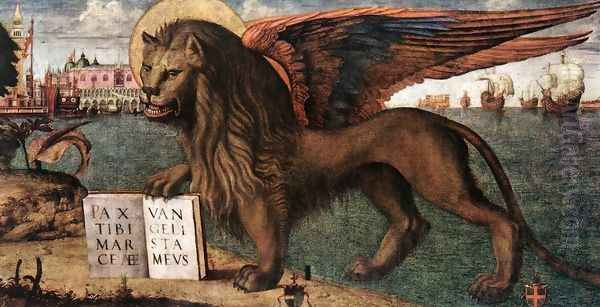
Carpaccio worked during a period of extraordinary artistic ferment in Venice. His career overlapped with the mature phases of Giovanni Bellini and Gentile Bellini, and he witnessed the rise of the artists who would define the Venetian High Renaissance. He shared the stage with other talented painters like Cima da Conegliano, known for his serene landscapes and Bellini-esque altarpieces, and Alvise Vivarini, head of a rival workshop known for a harder, more linear style influenced by Mantegna and Antonello da Messina.
His later years saw the meteoric rise of Giorgione, whose brief career revolutionized Venetian painting with its emphasis on colore (color/tone) over disegno (drawing/design) and its creation of evocative, poetic moods. Carpaccio’s narrative literalness stands in contrast to Giorgione’s enigmatic pastorals. He also saw the emergence of Titian, who built upon Giorgione's innovations to become the dominant figure in Venetian art for decades, mastering dynamic compositions, rich color, and profound psychological expression. Other significant contemporaries included Sebastiano del Piombo (who later moved to Rome), Palma Vecchio, and the slightly younger Lorenzo Lotto, whose psychologically intense portraits and idiosyncratic religious works offer another distinct strand of Venetian art. Carpaccio navigated this competitive and rapidly evolving scene, maintaining his own distinctive voice.
Legacy and Rediscovery
After his death, Carpaccio's fame gradually faded. While his major cycles remained visible in Venice, artistic tastes shifted, and during the Baroque and Neoclassical periods, his detailed, narrative style was less appreciated than the grand manner of Titian, Tintoretto, and Veronese. He was largely overlooked by art historians and collectors for centuries.
It was not until the 19th century that Carpaccio experienced a significant revival, largely thanks to the writings of the influential English art critic John Ruskin. Ruskin admired Carpaccio's truthfulness to nature, his detailed observation of Venetian life, and the moral clarity he perceived in his narratives. Ruskin praised Carpaccio lavishly in works like The Stones of Venice, bringing him back to the attention of scholars, artists, and the travelling public. Artists associated with the Pre-Raphaelite Brotherhood also found inspiration in his detailed style and narrative focus.

Today, Vittore Carpaccio is firmly established as a major figure of the Venetian Renaissance. His works are admired not only for their artistic merit – their compositional skill, narrative ingenuity, and delightful detail – but also for their invaluable role as historical documents. They offer an unparalleled visual record of Venice at the turn of the 16th century, capturing its architecture, costumes, maritime life, and ceremonial pageantry with loving precision. His ability to blend religious narrative with keen observation of the contemporary world gives his art an enduring freshness and appeal.
Conclusion
Vittore Carpaccio carved a unique niche for himself within the rich tapestry of Venetian Renaissance art. As a masterful storyteller in paint, he brought sacred legends and historical events to life with clarity, charm, and an extraordinary eye for detail. His large narrative cycles, particularly those for the Scuole di Sant'Orsola and San Giorgio degli Schiavoni, remain highlights of Venetian painting, enchanting viewers with their intricate depictions of pageantry and daily life. While perhaps less stylistically innovative than some of his contemporaries like Giovanni Bellini, Giorgione, or Titian, Carpaccio's dedication to narrative, his meticulous rendering, and his ability to capture the specific atmosphere of Venice make him an indispensable figure. His paintings continue to fascinate not just as works of art, but as vibrant windows onto the glorious world of Renaissance Venice.